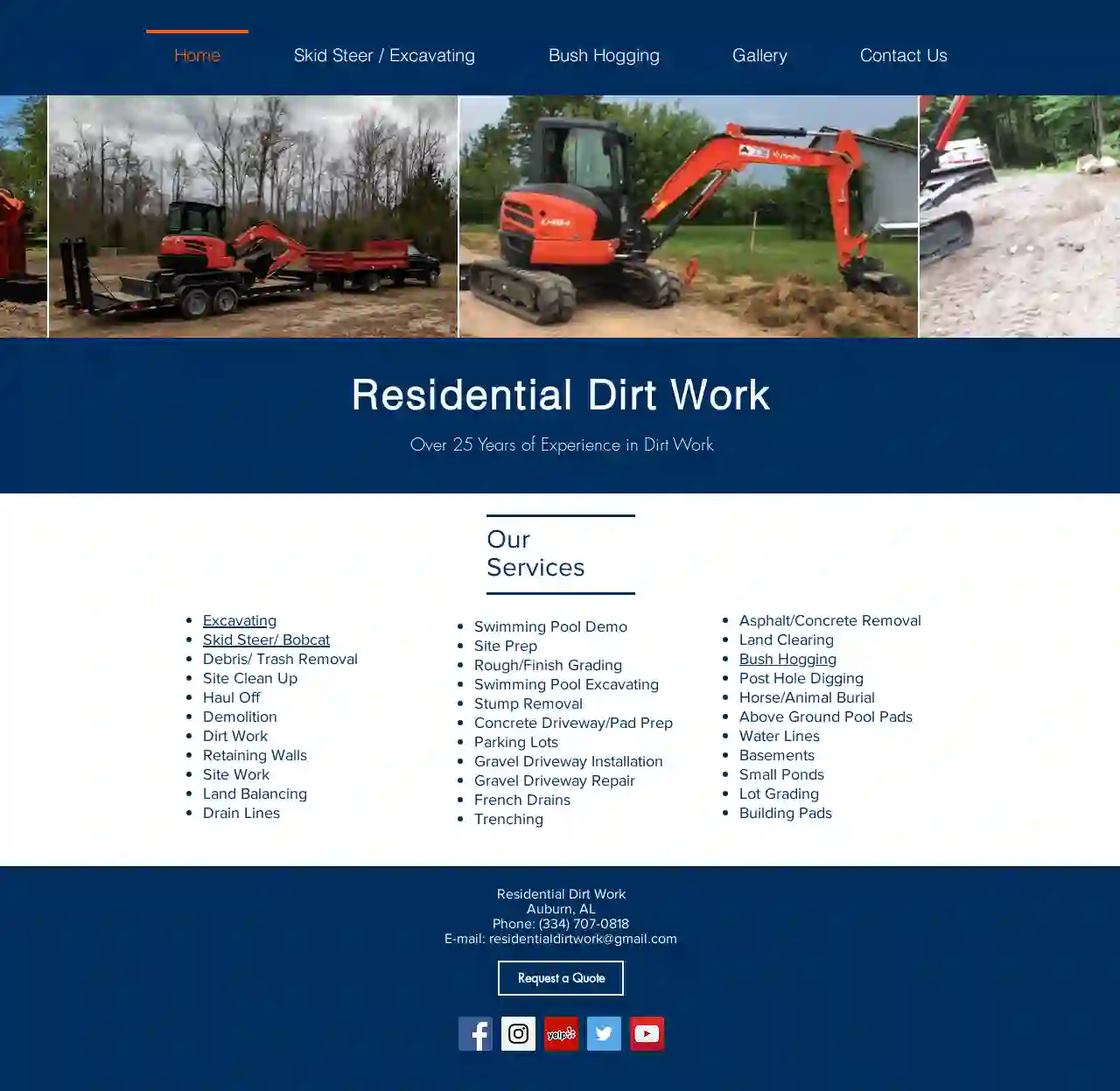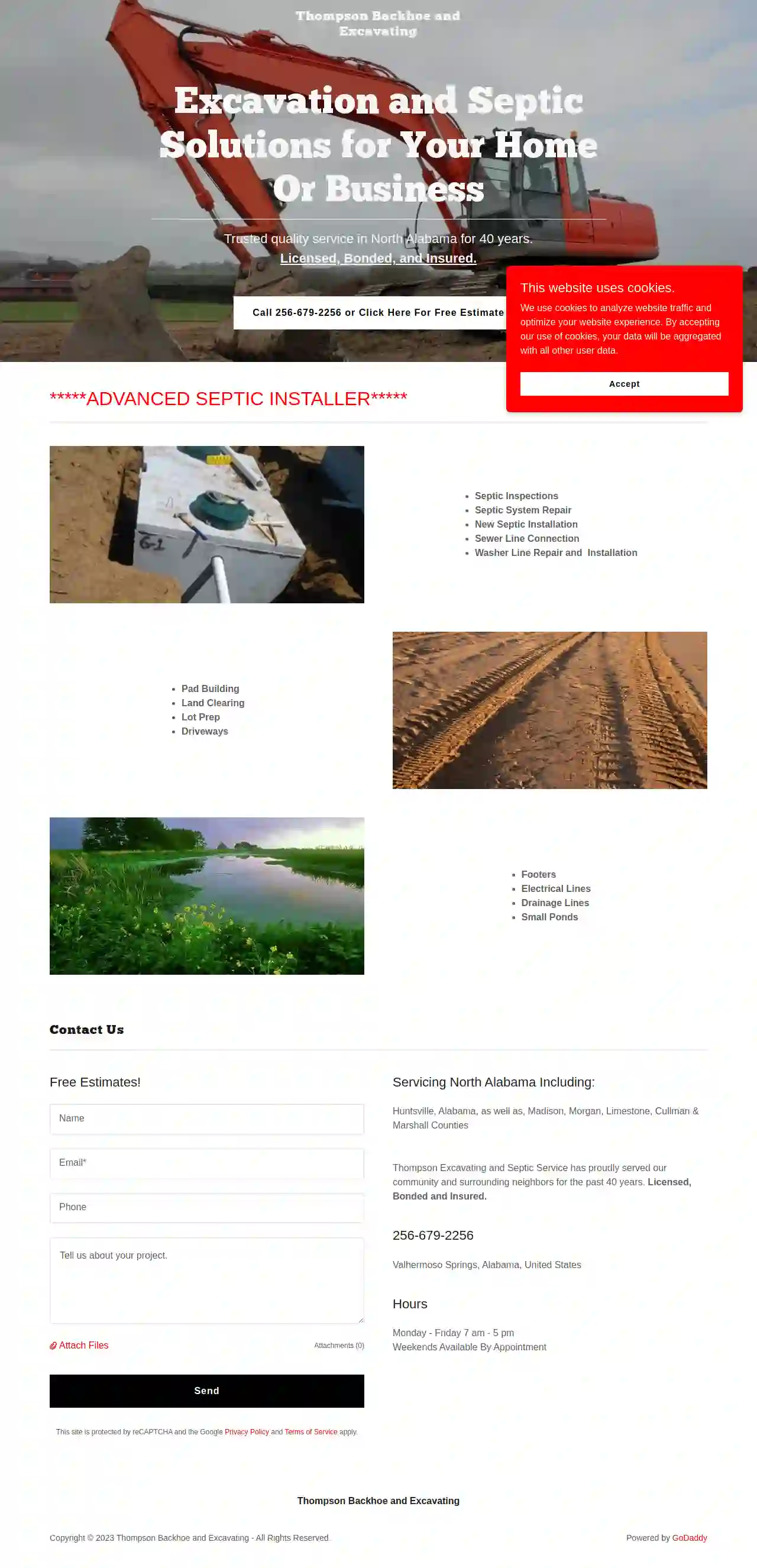Excavation Contractors Boaz
Find the best Excavation Services in Boaz
Receive 3 FREE Excavating Contractors quotes for your project today! Compare profiles, reviews, accreditations, portfolio, etc... and choose the best offer.

Godwin Land Solutions
552 reviewsHuntsville, USThank you in advance for choosing Godwin Land Solutions LLC for your next project. GLS is family owned and operated in Mobile County, Baldwin County and surrounding areas. The GLS team is a certified and experienced LLC. We are competent in our work to make sure the job is done correctly and completed in a timely manner. At GLS we strive for customer satisfaction and a quality result at the end of each project. Godwin Land Solutions is Licensed and Insured. We offer a large variety of Commercial and Residential Land Development & Site Preparation Services.
- Services
- Why Us?
- Gallery
Get Quote
Residential Dirt Work
530 reviewsHuntsville, USResidential Dirt Work Over 25 Years of Experience in Dirt Work
- Services
- Why Us?
- Gallery
Get Quote
Usa Pipe Repair
4.838 reviewsMobile, USThe plumber your plumber calls when they need help! USA Pipe Repair is an owner-operated, full-service plumbing company. We specialize in all forms of trenchless technology as well as general repairs from faucets to showers to entire house re-pipes and as little as changing a wax ring on a toilet. We work for many of the largest contractors in the area and our underground division covers the entire state working for other contractors because of our specialties. Our indoor division stays mainly in the Central Virginia area providing top-notch service at an affordable rate. Many of the larger companies that we work for don’t want to admit that they sub out to us. However, you can hear people advertising for us on the radio every morning and never know my company was there. We look forward to working for you and making sure that you are 100% satisfied. Confidently hire a plumber in Richmond, VA, and nearby areas from USA Pipe Repair and know that you'll also benefit from trenchless technology and top-quality work and results. We routinely work with many larger companies in the area that appreciate our skills and expertise. No need to dig! USA Pipe Repair will fix broken, cracked, or separated pipes with new cured in place pipe.
- Services
- Why Us?
- Gallery
Get Quote
Thompson Backhoe & Excavating
4.58 reviewsValhermoso Springs, USExcavation and Septic Solutions for Your Home Or Business Trusted quality service in North Alabama for 40 years. Licensed, Bonded, and Insured. Call 256-679-2256 or Click Here For Free Estimate
- Services
- Why Us?
- Gallery
Get Quote
Bama Dirt Bulk Yard Madison
4.662 reviewsP.O. Box 36, Anderson, 35610, USAbout Bama Dirt: North Alabama Aggregate Supply & Services We provide aggregate materials and services for residential markets of North Alabama. From small to large aggregate projects, we fulfill each order to meet customer specifications. We take pride in differentiating ourselves from other aggregate providers by providing exceptional customer service and quality, and we're commited to building solid, successful relationships with our customers. Based in Killen, Alabama, we serve all areas of North Alabama surrounding Florence, Muscle Shoals, Athens, Madison, Huntsville, Decatur, Cullman, Moulton, Hartselle, Sheffield and more. We travel as far west as the Mississippi line, and also serve areas of Southern Tennessee. If you have a question about whether we'll come to you, give us a call at 256-740-7406 or send us a quick message to learn more. Our quality aggregate materials have been used in a variety of residential landscaping projects throughout North Alabama and Southern Tennessee. Bama Dirt aggreates are commonly used for building or repairing driveways, ditch construction, erosion control, embankments, backfill, and other landscaping needs.We strive to maintain the highest quality and service possible by following the customer’s guidelines to guarantee our aggregates have met all project specifications. If you have a project you would like to discuss with us, call (256) 740-7406 or send us a few details for a free estimate or site evaluation. Bama Dirt has trained and experienced professionals that understand how to operate in the most delicate areas. With our committed workforce and our line of heavy duty equipment, Bama Dirt provides a full range of landscaping services to residential homeowners of North Alabama. Our services are utilized for land clearing for a small residential lot to driveway repair, culvert installation, French drains, sod installation, and much more. If you would like to learn more about our services, call us today at (256) 740-7406 to speak with a professional about your resdiential project. We provide free estimates and site evaluations throughout North Alabama.
- Services
- Why Us?
- Our Team
- Gallery
Get Quote
SK Excavating LLC
59 reviews161 Granada Lane, Guntersville, 35976, USSince 2015, SK Excavating LLC has been serving Guntersville, Alabama, and the surrounding area with professional-quality excavation and demolition services. We are a family-owned and operated business dedicated to providing every client with affordable service perfectly tailored to their needs. We offer a variety of excavation and demolition services ranging from land clearing to structural demolition. We welcome the opportunity to gain your trust to handle all of your excavation and demolition needs now and in the future. Our mission is to provide all clients with excavation and demolition solutions that will surpass their expectations. We treat every project with care and professionalism and strive to provide professional, timely, and affordable services. We are committed to building lasting relationships within the community and handling all of your excavation and demolition needs now and in the future.
- Services
- Why Us?
- Our Team
- Gallery
Get Quote
North Alabama Land Services
54 reviews11002 Vivian Drive NW, Huntsville, 35810, USNorth Alabama Land Services is here to help you! We are a family-owned and operated business with rock solid values that stand for honesty, integrity, and hard work. We know that your property is important to you, so it is important to us too. Therefore, we are not finished until you are satisfied. We look forward to meeting you, and getting to work on your next project. Please contact us to schedule your in person appointment for a free estimate. Your land, our expertise, endless possibilities. Unleash your land's potential with North Alabama Land Services.
- Services
- Why Us?
- Our Team
- Gallery
Get Quote
Roto-Rooter Plumbing and Water Cleanup
4.8Huntsville, USYour Local Roto-Rooter Plumber in Huntsville, AL Roto-Rooter delivers expert plumbing solutions in Huntsville, Alabama, that you can count on 24/7/365. Whether you’re struggling with sewer lines, water damage, or drain cleaning, our skilled plumbers are ready to tackle any plumbing challenge, large or small. Since 1935, Roto-Rooter has stood apart from the pack as Huntsville’s premier provider of drain cleaning and plumbing services. Our commitment to quality and customer satisfaction means that when you choose Roto-Rooter, you get: Same day service 24/7 availability Highly trained, experienced plumbers State-of-the-art diagnostics and equipment No hidden or extra charges for plumbing or drain service on holidays, nights, and weekends Free onsite and upfront estimates Fully licensed, insured, experienced plumbers Senior and military discounts Special financing options available Schedule your appointment with our Huntsville plumbing experts via our online form, or call our 24/7/365 service line at 256-533-7246. Comprehensive Plumbing Solutions in Huntsville, AL No matter what plumbing problem you’re facing, Roto-Rooter has the expertise and experience to get the job done right. We offer a wide range of plumbing services, including:
- Services
- Why Us?
- Testimonials
- Gallery
Get Quote
Cascade Environmental
41 reviews22722 29th Drive SE, STE 228, Bothell, WA, 98021, USAbout Us Cascade is the leading provider of environmental and geotechnical drilling, site characterization and remediation in the United States. Cascade has the right equipment, experience and expertise to do the job. Our fleet includes track-mounted, truck-mounted, and limited access rigs, allowing us to access any site. Our remediation services focus on subsurface investigation and remediation applications. We partner with you to deliver the right technology and implementation expertise for every project, no matter how routine or complex.
- Services
- Why Us?
- Gallery
Get Quote
Kennedy and Sons Structural Solutions
4100 reviews7201 Stringfield Road Northwest, Huntsville, 35806, US78 Years Of History and Innovation Kennedy and Sons Structural Solutions has been serving Alabama, Georgia, Mississippi, and Tennessee communities for over 78 years. We specialize in Huntsville commercial foundation repair for all types of construction, including commercial, residential, government, and more! Contact us today to schedule an estimate. A Legacy Built On Trust At Kennedy and Sons Structural Solutions, we get to the root cause of the problem and fix it permanently! No band-aids, no patches, no widgets and buzzwords. Just customized solutions that work so we can guarantee our work over a lifetime. “No other company in North Alabama knows more about moving heavy structures and repairing a building’s foundation than we do at Kennedy and Sons Structural Solutions. It is just a fact. My Dad (Don) did it up until I bought the company from him in 1990, and his father (Harry) did it before him when he started the company in 1945. For 70 years my family has been moving houses and repairing foundations and in all those years, we have moved what some people said were unmovable, without a single glitch.”- Jeff Kennedy, President
- Services
- Why Us?
- Gallery
Get Quote
Over 22,076+ Excavation Businesses on our platform
Our excavation pros operate in Boaz & surrounding areas!
ExcavationHQ has curated and vetted the Best Excavation Contractors near Boaz. Find a top & trustworthy business today.
Frequently Asked Questions About Excavation Contractors
- Utility Locates: Contact your utility companies to mark the locations of underground lines before excavation begins. This is usually a free service.
- Hand Digging: Excavate carefully by hand near marked utility lines to avoid damage.
- Potholing: Digging small test holes to expose and verify utility depths and locations.
- Safe Distances: Maintaining a safe distance between excavation equipment and marked utility lines.
- Vacuum Excavation: Using vacuum excavation techniques to expose utilities without digging, reducing the risk of damage.
- Hauling to Designated Disposal Sites: Transporting excavated material to approved landfills or recycling centers.
- Recycling or Reuse: If suitable, some excavated soil might be recycled for other projects or reused on-site for landscaping or backfilling.
- Complying with Regulations: Adhering to local and environmental regulations for soil disposal to prevent contamination or illegal dumping.
- Basement Size: The larger the basement, the more excavation is required, increasing the cost.
- Soil Type: Excavating rocky or dense clay soil is generally more expensive than loose soil.
- Accessibility: Difficult-to-access sites might require specialized equipment or more labor, driving up costs.
- Foundation Type: The chosen foundation type (full basement, crawl space, slab) affects excavation needs.
- Underpinning: If underpinning (strengthening existing foundations) is necessary, it significantly increases costs.
- Disposal Fees: Hauling excavated soil to disposal sites adds to the overall expense.
- Soil Type and Stability: Stable, cohesive soils allow for deeper excavations than loose or unstable soils.
- Groundwater Level: Excavations below the water table require dewatering techniques to manage water intrusion.
- Equipment and Resources: The size and capabilities of excavation equipment influence the achievable depth.
- Safety Regulations: OSHA and other safety regulations impose limitations on trench depths without proper shoring or sloping.
- Project Requirements: The purpose of the excavation (basement, pool, foundation) determines the necessary depth.
How do you protect utilities during excavation?
How do you handle soil disposal after excavation?
How much does it cost to excavate a basement?
How deep can you excavate?
How do you protect utilities during excavation?
- Utility Locates: Contact your utility companies to mark the locations of underground lines before excavation begins. This is usually a free service.
- Hand Digging: Excavate carefully by hand near marked utility lines to avoid damage.
- Potholing: Digging small test holes to expose and verify utility depths and locations.
- Safe Distances: Maintaining a safe distance between excavation equipment and marked utility lines.
- Vacuum Excavation: Using vacuum excavation techniques to expose utilities without digging, reducing the risk of damage.
How do you handle soil disposal after excavation?
- Hauling to Designated Disposal Sites: Transporting excavated material to approved landfills or recycling centers.
- Recycling or Reuse: If suitable, some excavated soil might be recycled for other projects or reused on-site for landscaping or backfilling.
- Complying with Regulations: Adhering to local and environmental regulations for soil disposal to prevent contamination or illegal dumping.
How much does it cost to excavate a basement?
- Basement Size: The larger the basement, the more excavation is required, increasing the cost.
- Soil Type: Excavating rocky or dense clay soil is generally more expensive than loose soil.
- Accessibility: Difficult-to-access sites might require specialized equipment or more labor, driving up costs.
- Foundation Type: The chosen foundation type (full basement, crawl space, slab) affects excavation needs.
- Underpinning: If underpinning (strengthening existing foundations) is necessary, it significantly increases costs.
- Disposal Fees: Hauling excavated soil to disposal sites adds to the overall expense.
How deep can you excavate?
- Soil Type and Stability: Stable, cohesive soils allow for deeper excavations than loose or unstable soils.
- Groundwater Level: Excavations below the water table require dewatering techniques to manage water intrusion.
- Equipment and Resources: The size and capabilities of excavation equipment influence the achievable depth.
- Safety Regulations: OSHA and other safety regulations impose limitations on trench depths without proper shoring or sloping.
- Project Requirements: The purpose of the excavation (basement, pool, foundation) determines the necessary depth.